February 24, 2022 – RSB Weekly Summary (see chart below)
The Ministry of Education (MEQ) recently acquired 90,000 carbon dioxide (CO2) detectors with the goal of having them installed in all Québec classrooms to ensure rigorous monitoring of indoor air quality.
Riverside School Board installs the devices in all classrooms as soon as they are received. These devices measure the concentration of CO2 in classrooms as well as the temperature and relative humidity. The data thus collected target areas that require remedial action, as the case may be. The collection and analysis of these data also provide a real-time snapshot of comfort settings. School principals can then take the necessary steps to ensure good air quality is maintained in their institution’s classrooms.
Bear in mind that CO2 is produced naturally through human breathing and that its presence in school buildings has no health effects. However, CO2 levels are an indicator of the quality of ventilation and an indicator of comfort. The Ministry aims for an average daily CO2 concentration of less than 1,000 parts per million (ppm). This target is used to guide air quality improvements in educational institutions in the coming years. Of note, an average daily CO2 concentration of less than 1,500 ppm is an indicator of adequate ventilation.
To ensure the above-mentioned average daily values are met, two approaches were selected to control the concentration of CO2 in classrooms:
- Educational institution staff use the data displayed on the detectors to ensure that CO2 concentrations in the premises do not exceed 1,500 ppm. Teachers respond directly to optimize the opening of windows and doors as set out in the air quality management protocol;
- The Riverside School Board’s Material Resources Department collects and analyses the daily averages recorded in order to plan and prioritize the various improvements to be made.
As part of the management of air quality in our educational institutions, it is important to remember that the MEQ works with public health authorities. Hence, this collaborative approach with independent ventilation and indoor air quality experts aims to maintain well-ventilated school settings over the long term, well beyond the COVID-19 pandemic.
For more information, consult the webpage on air quality in schools at Québec.ca: https://www. https://www.quebec.ca/en/education/preschool-elementary-and-secondary-schools/air-quality-schools.
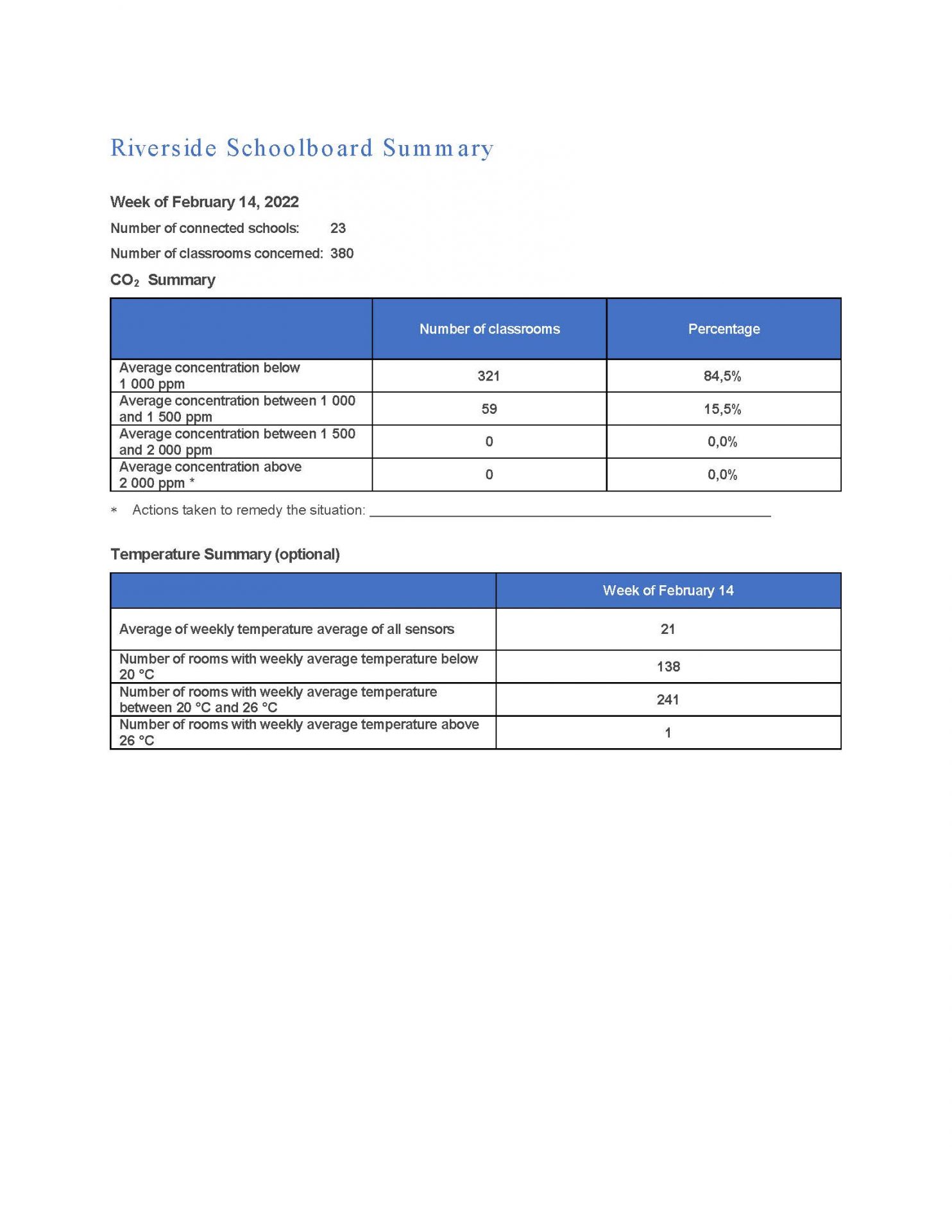
February 23, 2022 – Air quality in schools – Encouraging first data
To read the NEWS PROVIDED BY the Ministry of Education, click here. (French only)
January 19, 2022 – Update on CO2 sensors
To date, 15 out of 26 schools have their indoor air quality (IAQ) sensors installed and operational. All sensors received to date are installed. We install the sensors diligently as soon as we receive them.
Do you have questions regarding the installation of CO2 sensors in our schools and centres? Click here to read the MEQ Q&A.
You can also visit the Government of Québec webpage by clicking here.
November 18, 2021 – Air quality and installation of CO2 sensors
Below you will find a communication drafted by the Ministry in collaboration with representatives of the education network and various government partners regarding the installation of CO2 sensors in our schools and centers.
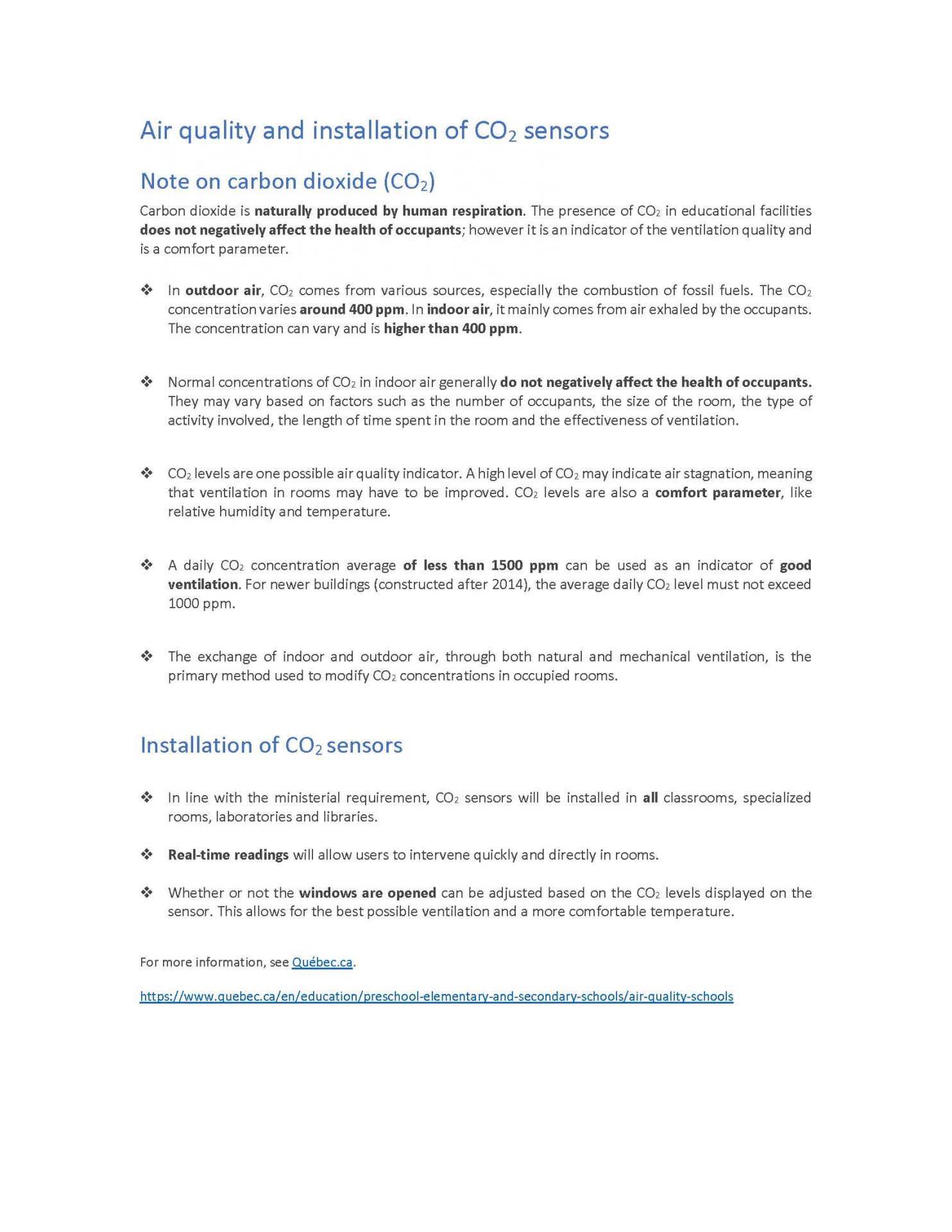
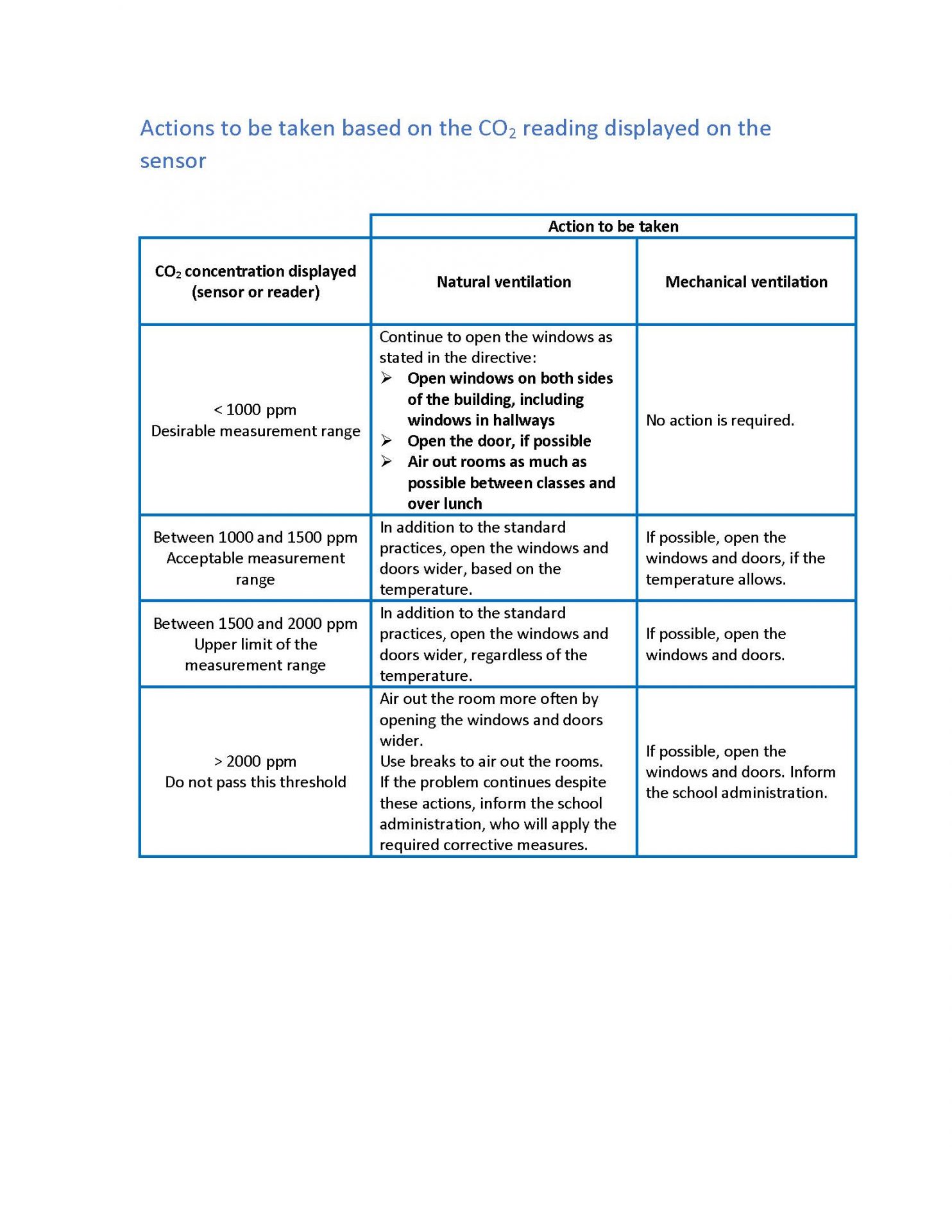
September 15, 2021 – Air Quality in Schools
Air quality and installation of CO2 sensors in all classrooms in Québec
A unique initiative Installing sensors in learning areas in schools allows for ongoing data collection so that necessary changes can be made more quickly. Québec is a leader with regard to this large-scale operation, as it is the first of its kind in Canada. This initiative is part of the program launched by the Ministère de l’Éducation for systematic testing of the following three air quality parameters within school buildings: level of carbon dioxide (CO2), relative humidity, and temperature.
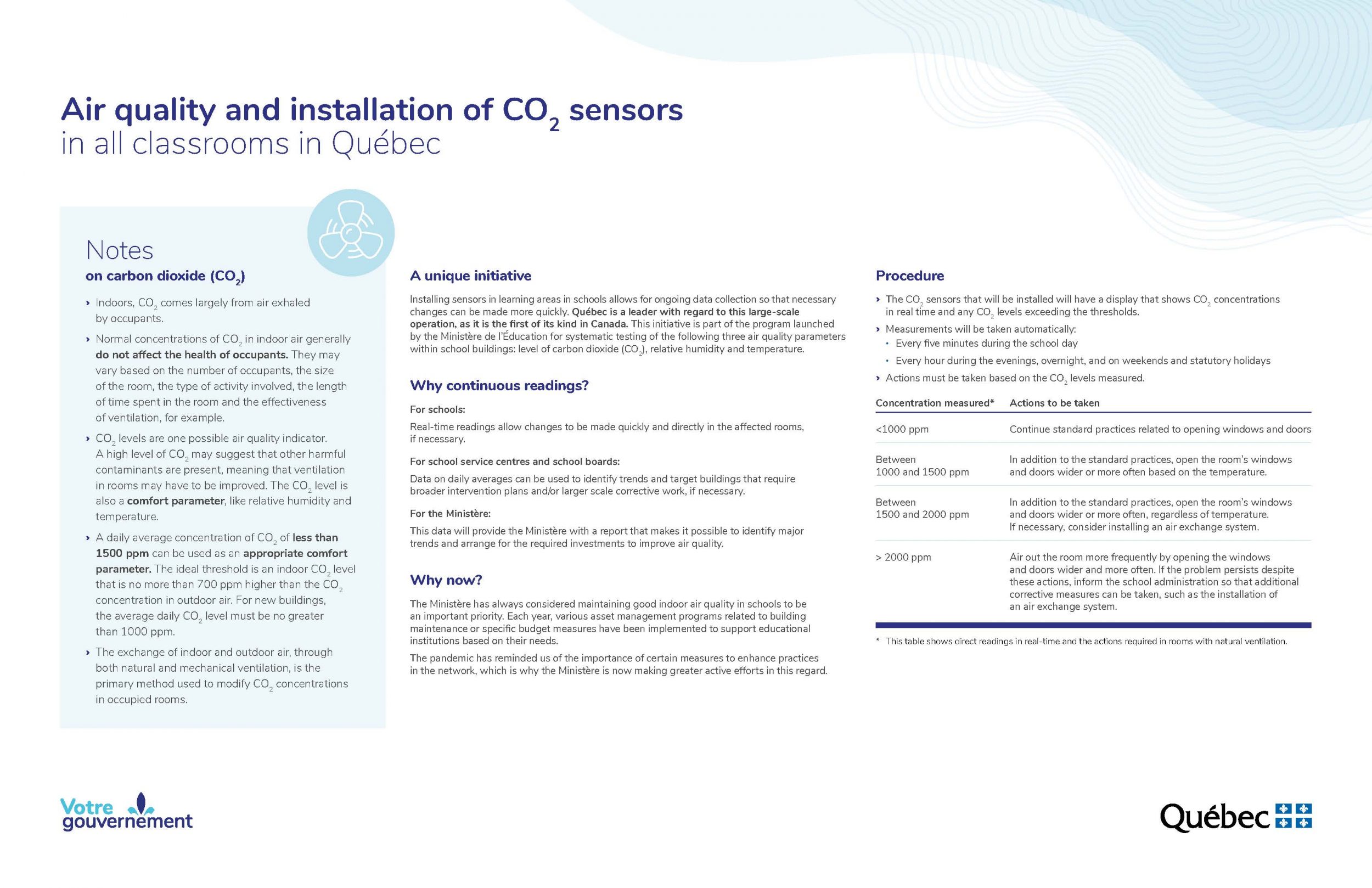
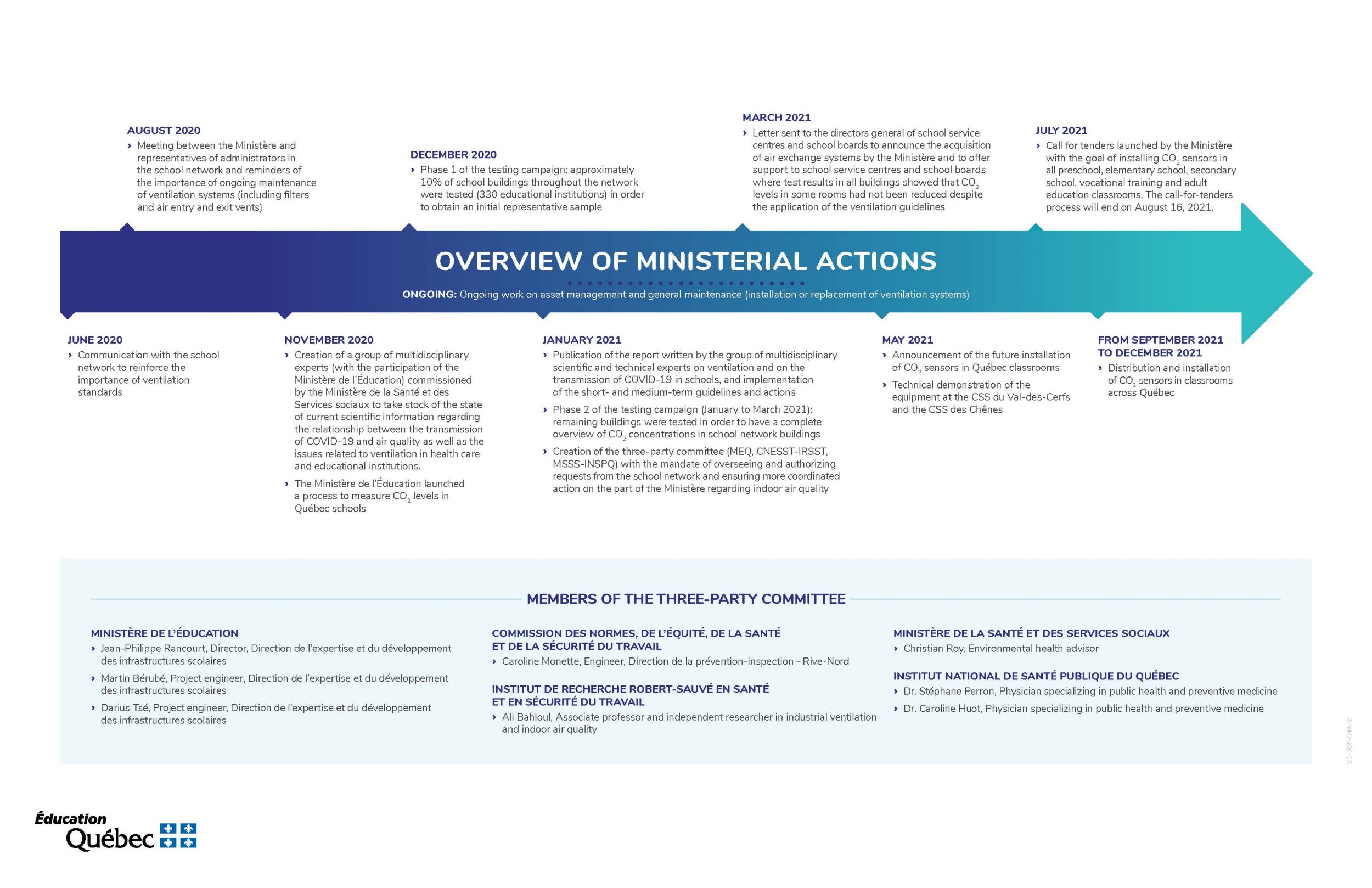
April 20, 2021 – Press Release from the Government of Québec
March 22, 2021, Update – CO2 Sampling
As you know, we recently carried out carbon dioxide (CO2) measurements in all our schools and centres to ensure air quality. The result of the CO2 measurements, which have also been sent to the Ministry of Education, can be viewed by visiting each of our school web pages (Blog – Reports), or you can click here to view the full document.
It is essential for us to ensure the quality of the air in our establishments. The health and safety of students and staff is our top priority, especially at this exceptional time. Therefore, the tests were carried out according to ministerial directives, to adequately measure the level of carbon dioxide in our premises, which gives a good idea of the air quality.
Analysis procedure
For each of the classes identified, the CO₂ level was measured three times during a period of the class, namely before and at the middle of the class. The third measurement was taken after opening the windows or the door for a period of 20 minutes. Although the Department of Education considers CO2 concentrations below 1500 ppm acceptable, school boards are encouraged to take measures to aim for the target of 1000 ppm, established by Health Canada as the comfort level. Action must be taken quickly when concentrations exceed 1000 ppm and within a week, when they reach 2000 ppm.
The identified classes were chosen in order to represent the overall portrait of the school according to the configuration of the classes (orientation in relation to the wind and the sun, the floor on which it is located, number of windows, type of ventilation, etc.) as well as according to the occupants of the class (school level, number of occupants, etc.).
Actions taken locally
In order to ensure optimal air quality in the classrooms, all have been asked to apply the prescribed measures.
In the case of schools and centres with mechanical ventilation, material resources have ensured its proper operation and efficiency. In the case of schools and centres with natural ventilation, the opening of windows and doors is applied to ensure the renewal of air.
In addition, each school has been equipped with a portable CO2 measuring device. This equipment allows the school team to monitor and validate the actions implemented, if necessary.
All the health measures put in place to curb the spread of COVID-19 also help to ensure the health and safety of all.
On January 13, 2021, we received new directives from the MEQ asking all school boards and service centres to continue with the CO2 levels sampling in all our buildings.
For each building, measurements will be taken with the same procedure in four to ten classes. Classrooms will be chosen so that they are representative of the entire school (different orientations in relation to the wind, different grade levels, different floors, different dates of construction, etc.). So corrective actions, if any, can be applied to similar classes. In the same school, if possible, measurements will be taken in the morning and in the afternoon.
Along with CO2 level measurements, the relative humidity and temperature measurements will also be taken.
The above parameters will be measured whether the room is mechanically or naturally ventilated.
If at the end of the exercise, the CO2 level measured in a naturally ventilated classroom exceeds the value of 1000 ppm, the teacher and the administration responsible for the building will be advised to open the windows more regularly.
In a mechanically ventilated classroom, if the measured CO2 level exceeds 1000 ppm, an inspection of the ventilation system will be made and corrective measures are taken to improve the situation, for example by increasing the flow of fresh air.
Once the corrective actions are in place, C02 measures will be taken again to ensure their effectiveness.
All the measurement and corrective action exercises will be carried out in close collaboration with the school principals and should be completed by the end of March.
In order to document the possibility of transmission of COVID-19 by aerosols, the Ministère de l’éducation du Québec (MEQ) asked us to proceed with the air sampling to establish a portrait of carbon dioxide (CO2) concentration in our classrooms.
More specifically, we are undertaking measurements of the carbon dioxide (CO2) level, in a representative sample of the school board buildings in order to ensure that the CO2 concentration in the air of classrooms complies with applicable standards. The level of CO2 is an indicator of the intake of fresh air in a room. A high intake of fresh air indicates proper air circulation and aerosol dispersion.
To ensure the quality and uniformity of the tests that will be performed a procedure has been set out by the MEQ and will be followed by all school boards and service centres in Québec.
The schools are selected according to set parameters so that Elementary, Secondary, and Centres will be sampled and that schools with natural and mechanical ventilation will also be sampled. Not all schools will be visited, but it will reflect the majority of situations in the school board.
In each designated school, at least 4 classrooms will be tested at 3 different times, namely prior to students’ arrival, after 20 minutes of teaching activities, and after opening the windows, in order to get a full portrait.
Should any deviation in the CO2 level from the applicable standards be identified, corrective measures will be implemented board-wide to address all situations in similar circumstances.

Ventilation in schools in the summer months
June 3, 2021 – In the current context of the COVID-19 pandemic, as a general rule, the use of standing fans or portable air conditioning units is not recommended, as these increase the risk of the spread of droplets and that could cause outbreaks.
Recommendations and measures to help comfort
- Drink often, without waiting to be thirsty. Bring a water bottle to school.
- Keep windows and doors open until 10 a.m.
- Close curtains or blinds when the sun is strong.
- During the day, it is recommended to ensure a supply of new air at least 3 times a day for a period of about 15 minutes.
- Encourage teaching outdoors on playgrounds or other areas in the shade or by using a sun shelter allowing the circulation of the cooling wind.
- When possible, keep lights and electrical appliances off during class.
- However, public health permits the use of standing fans or portable air conditioning units as a last resort when temperatures reach extreme levels and other preferred means are no longer sufficient to ensure the comfort of students and staff.
In all cases, it is essential to continue to diligently apply the health measures in force: wearing a mask, physical distancing, hand hygiene, cleaning of surfaces.
On January 8, 2021, the INSPQ released the report from the group of scientific and technical experts on the transmission of COVID-19 in schools and healthcare settings and on the role of ventilation. Based on this report we received, on January 13, 2021, new directives from the MEQ indicating that it is not recommended to use mobile filtration devices (or air purifiers) in schools, due to:
- Their effectiveness, not yet demonstrated to counter the transmission of diseases by aerosol;
- Their reduced efficiency in a large room (such as a classroom where sources of potentially infectious particles are dispersed or far from the device);
- The risk of inappropriate use (possible generation of airflow carrying aerosols);
- The noise they make could interfere with concentration.
The installation of such equipment can also generate a false sense of security. These devices are not able to counter the transmission of COVID-19 through close contact with an infected person, which is the main recognized mode of transmission.
On November 27, 2020, the ministère de l’Éducation (MEQ) issued a report on school boards’ indoor air quality management plans which includes aspects of housekeeping, preventive maintenance of ventilation equipment, Indoor Air Quality (IAQ) management as well as their register for materials that may contain asbestos and radon. This report is based on documents that school boards have to file with the Ministry.
For Riverside School Board, however, a chain of unfortunate events linked to the electronic transmission of our documentations prevented our data from being included in the MEQ report. Please see the information below that should have been included in the MEQ’s report:
| 1 | 2 | 3 | 4 | 5 | 6 | 7 |
| % Progress on Housekeeping | % Progress on Ventilation | % Progress on Implementation of Electromechanical Maintenance Plan | % Global Progress on Implementation of IAQ Management Plan | % of Progress on Registered Material Likely to Contain asbestos | % Progress on Radon Concentration Readings | % Progress on Installation of Cabon Monoxide Detectors |
| 100% | 100% | 91.25 % | 100% | 100% | 100% | 100% |
Opening of windows
We would like to clarify our directives regarding the opening of windows in our schools. For schools that do not have mechanical ventilation, opening the windows is the best way to get fresh air into the classrooms. Material Resources sent recommendations to the schools as follows: Open windows for 15 minutes in the morning, at recess, lunch, afternoon recess, and at the end of the day when students are not in the class. However, please keep in mind that schools that have high windows, for teachers that also supervise recesses, for lunches that are taken in class, for rainy days, etc., it is possible that those directives cannot be followed to the letter, but Public Heath directives are always respected. Regardless, it is always better to open the windows during the day. Therefore, it could happen that windows are open when students are in class. We ask that students come to school with an extra layer, IN CASE windows need to be open when they are in class. Please know that our schools and teachers are doing their best for the students’ well-being.
We thank you for your understanding.
We would like to address the many questions and concerns that we received from parents regarding ventilation in our schools. Please find below the series of actions carried out in our establishments regarding ventilation. These procedures have been implemented since the beginning of the year in accordance with Public Health directives and recommendations from the INSPQ.
Windows
The vast majority of our Schools and Centres have windows that open so this is why we promote natural ventilation of the premises by opening them regularly (before class, during recess, during the lunch hour, or when students are attending gym classes, etc.). This practice is also the main recommendation of the INSPQ.
Mechanical Ventilation
If classrooms have windows that do not open, it is because the school is equipped with a mechanical ventilation system. Please know that these systems are in good working order.
Monitoring of our Systems
Our Material Resources Team regularly monitors the condition of the ventilation systems in our Schools and Centres and performs ongoing maintenance. Notably, all ventilation system filters are regularly changed many times a year, surpassing the standards set by the manufacturers. In the context of the pandemic, not only are we continuing to monitor, but we have also extended the operating hours of the ventilation systems from operating them when the buildings are occupied to all the time (24/7) in order to promote the renewal of the air inside our buildings. In addition, we specifically check the mechanical components to ensure that the classrooms are well supplied.
Ministry
In addition, you may have seen circulating in the media that the Ministry of Health plans to form a Panel of Experts that will include specialists from INSPQ and the Ministry of Health who will be making recommendations by the end of November, regarding, amongst other things, ventilation in schools. The recommendations from this Panel will be implemented in our communities, as will those already issued by INSPQ and Public Health.
We hope that these clarifications will ease concerns in regards to the ventilation in our Schools and Centres.
Our students’ and staff’s well-being is a priority.